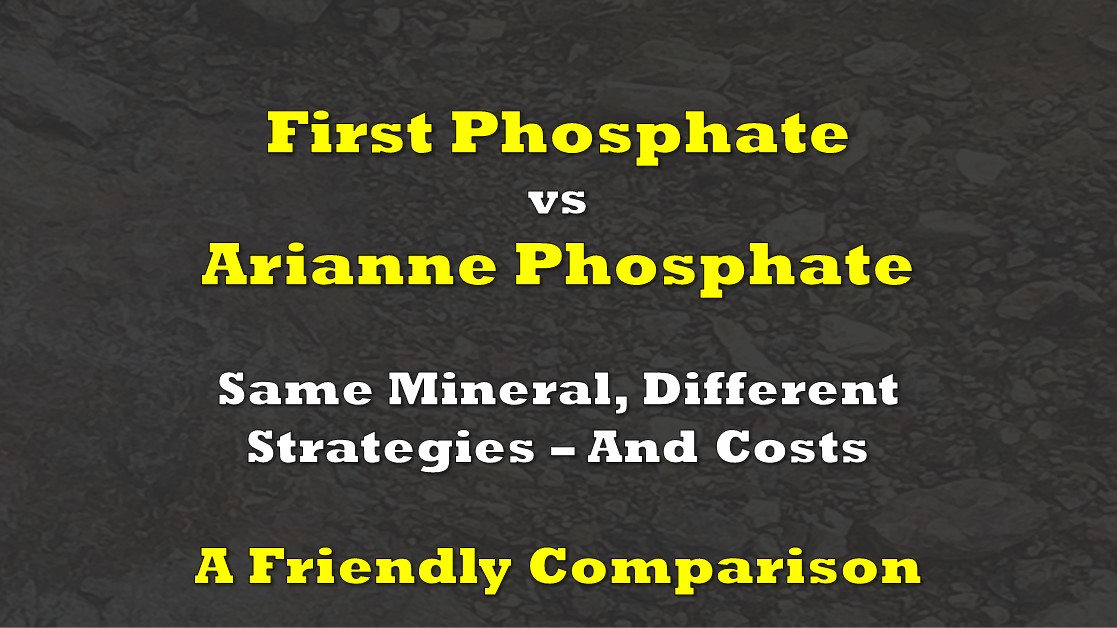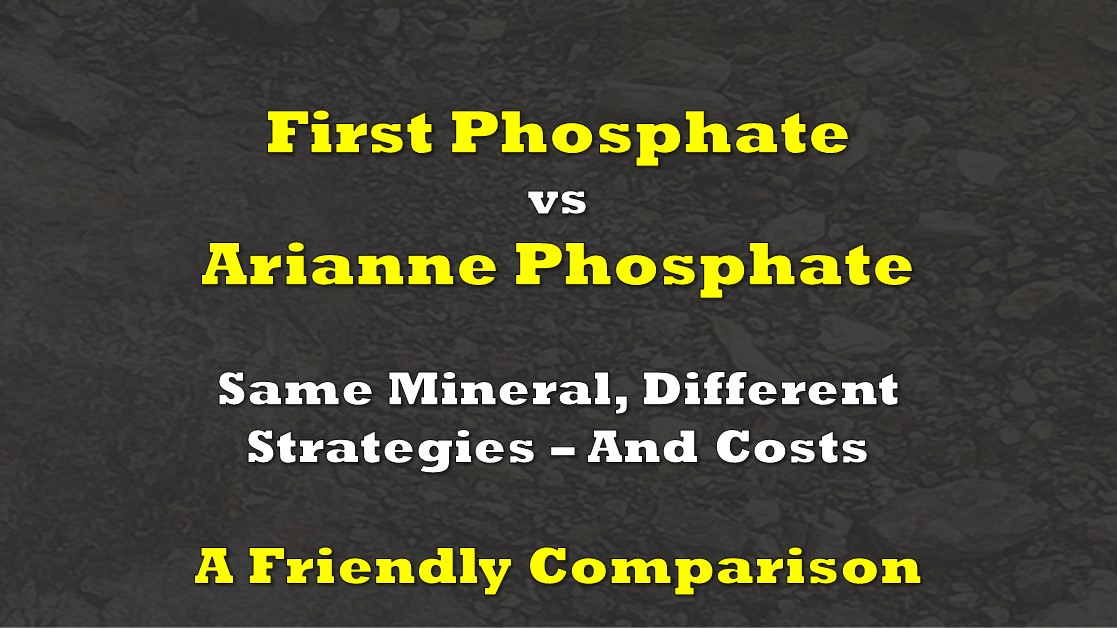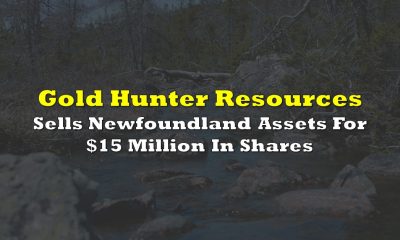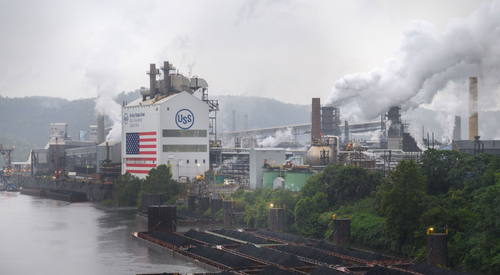Base Metals
First Phosphate & Arianne Phosphate: Same Mineral, Different Strategies – And Costs
FULL DISCLOSURE: First Phosphate is a client of Canacom Group, the parent company of The Deep Dive. The author has
The post First Phosphate & Arianne…

FULL DISCLOSURE: First Phosphate is a client of Canacom Group, the parent company of The Deep Dive. The author has been compensated to cover First Phosphate on The Deep Dive, with The Deep Dive having full editorial control. Not a recommendation to buy or sell. We may buy or sell securities in the company at any time. Always do additional research and consult a professional before purchasing a security.
First Phosphate (CSE: PHOS) and Arianne Phosphate (TSXV: DAN) are the two phosphate players in the Saguenay-Lac-St-Jean Region of Quebec. As this area has the opportunity to become the epicenter of North America’s rapidly growing lithium iron phosphate (LFP) battery industry, it is important that investors understand the nuances that each company brings to the table, and how this affects project costs.
The production strategy
In a nutshell, First Phosphate is focused on a value-added niche strategy specifically around LFP battery, while Arianne Phosphate is focused on a bulk concentrate model mostly based on fertilizer input but potentially also, in part, on LFP battery.
First Phosphate is ESG-driven, with a focus on producing a critical supply of clean, high-purity, low-carbon-footprint battery-grade purified phosphoric acid (PPA) which it will use in the production of LFP cathode active material for the LFP battery industry. The company is likely the only private or public company worldwide that is 100% focused on becoming a major long-term supplier of LFP cathode active material to North America’s LFP battery manufacturers. At the same time, First Phosphate is focused on minimizing infrastructure costs and maximizing value-add with preliminary plans calling for a production profile of 500,000 tonnes per annum of phosphate concentrate.
Arianne’s focus, meanwhile, is on becoming a large commodity based producer of phosphate concentrate from its Lac a Paul project. It is considered to be one of the world’s largest undeveloped phosphate deposits that is not owned by a major fertilizer company. Arianne aims to sell its phosphate concentrate to other value-added players – mostly in the fertilizer arena and potentially in the LFP materials space- and has projected annual mine production slated at 3,000,000 tonnes per annum of phosphate concentrate.
Business models: The same timeline?
First Phosphate, since initiating operations less than a year ago, has moved rapidly and with clear intention towards advancing towards a preliminary economic assessment and the development of its value-added downstream processes. Key to its plan is to not have to build new infrastructure, with the company emphasizing that its properties are as close as 140 km and 75 km from the existing deep sea port infrastructure at Port Saguenay. First Phosphate is planning to use the facilities of the existing south-shore port of Saguenay to cut down on infrastructure costs. Moreover, the Quebec government has recently committed $105 million to upgrading all services at Port Saguenay, a massive benefit for First Phosphate.
Arianne’s plan, meanwhile, includes the build-out of a new port facility on the north shore of the Saguenay River, one which was projected to cost about $400 million (in 2013 dollars), and which could add perhaps up to 3-5 years of lead time from ground-breaking before Arianne could actually export its phosphate concentrate. The new port facility is a requirement given the bulk concentrate model currently targeted by the company. Arianne’s Lac a Paul Project is 300 km from the existing Port of Saguenay and 250 km away from the potential new sea port it plans to build.
The implication of these logistical considerations is that First Phosphate will be able to sell or to add value to its phosphate concentrate as soon as it has permits and as soon as its mine is built. Arianne, on the other hand, will only be able to sell its phosphate concentrate once its additional and costly new port infrastructure has been built on top of when its mine is built (either before or in tandem with the new port).

Cost of $400 million to build in 2013 dollars. Unknown cost today.

Quebec government recently invested $105 million in upgrading the port.
.
First Phosphate and Arianne Phosphate: A quick and friendly comparison
| Details | First Phosphate Corp. | Arianne Phosphate |
|---|---|---|
| Land Position Size | 1,500 km2 | 276 km2 |
| NSR Free | Yes | Unknown |
| Driving Distance to Existing Port | 75 km (Bégin-Lamarche) 140 km (Lac à l’Orignal ) |
300 km (Lac-à-Paul) |
| Mineralized Zones | 4 (Lac à l’Orignal) | 9 |
| Phosphate Grade | 5.2% P2O5 (Lac à l’Orignal) 8-10% P2O5 (Bégin-Lamarche in initial drilling) |
6.88% P2O5 (Lac à Paul) |
| Resources | 49.0 million tonnes indicated & inferred (Lac à l’Orignal) Bégin-Lamarche not yet quantified |
472 million tonnes proven & probable |
| Property Stage | PEA expected Q4 2023 | FS released October 2013 |
| Permit Status | In process at PEA stage | Permit expires December 2025 |
| Type of Mine / Mine Life | Open Pit – Targeted at 12-15 years (PEA dependent) | Open Pit – 26 years |
| Mine Production (tonnes per annum) | Targeting 500,000 | 3,000,000 |
| Truck Transportation | Targeting standard 52 tonne trucks | Oversize 100 tonne trucks |
| Trucking Restrictions | None (targeted) | Heavy haul gravel road only. No provincial highways. |
| Offtake Agreements | Yes (finalizing) | Yes (dated) |
| Focus | 100% LFP | Fertilizer, potentially LFP |
| MGA Production Facility | Proposed at Port of Saguenay | Proposed at Belledune, NB |
| PPA Production Facility | Proposed at Port of Saguenay | No current plans |
| LFP Cathode Active Material Facility | Proposed at Port of Saguenay | No current plans |
| Internalization of own Production for Value-Add | Yes | Potentially |
| Downstream LFP Value Added Partners | Prayon (PPA, LFP) IPL Technologies (LFP) |
None as of yet |
| Processing of Secondary Recoveries | Plans to process ilmenite to synthetic rutile and iron sulphate for use in LFP Cam production. Plans to process magnetite to pig iron |
Will stockpile ilmenite and magnetite recoveries at onset |
| Potential ESG Compliant Resource for LFP battery | Verified by Queen’s University Study | TBD |
| CAPEX | TBD in PEA | US$1.55 Billion plus potential third party infrastructure buildout (Saguenay north shore port) |
| Existing Port Access | Yes, at Port of Saguenay on the south shore (existing infrastructure) | No – Proposing to build a new port on the north shore of Saguenay (new expensive infrastructure) |
| Market Capitalization | $34 million | $91 million |
CapEx expectations
First Phosphate is scheduled to complete its PEA on the Lac à l’Orignal phosphate property in late 2023. At that time, an accurate CAPEX comparison will be able to be made between First Phosphate and Arianne.
First Phosphate is anticipated to have a much lower CapEx requirement, however, since its mine is much smaller and closer to existing infrastructure and since it does not require the building of a new port in order to ship or to add value to its products.
In March of 2023, Arianne updated the CapEx estimate for their Lac-a-Paul Project to US$1.55 billion, which includes the building of a new port facility on the Saguenay River’s north shore. Arianne currently cannot access the existing south shore Port of Saguenay because of the large amount of tonnage that it must produce to amortize its CapEx requirements. The CapEx on this new proposed port facility was pegged at $400 Million in 2013 dollars, but was not broken down in the most recent update.
It is unforeseeable whether the Quebec government would be willing to contribute further monies at this point to the construction of Arianne’s proposed north shore port when it has just committed $105 million to upgrading the existing south shore Port of Saguenay to the benefit of First Phosphate.
Trucks, roads & restrictions
Beyond the differences in port requirements for both companies, the disparities in trucking distances for both projects are rather pronounced as well. First Phosphate, whose flagship property is located at 140 km from existing port facilities, is able to use standard 52 tonne trucks to bring material to the existing Port of Saguenay. First Phosphate can use existing provincial roads to reach the existing deep sea port of Saguenay with a direct few hour haul from its property.
Arianne, on the other hand, whose property is 300 km away from the existing port facilities (and 250 km away from the planned new port facilities that it wishes to build), is planning to use oversized 100 tonne trucks to export large volumes of phosphate concentrate. As such, Arianne cannot use the existing provincial highway network which is limited to 52 tonne trucks.
Arianne is proposing to move its phosphate concentrate from Lac-a-Paul with 100 tonne oversized trucks (which cannot circulate on regular provincial roadways) to the new port facility on the north shore of the Saguenay for which it would require major CapEx to build ($400 million in 2013 dollars). Moreover, Arianne can only use heavy haul gravel roads for transportation – i.e. no provincial highways because it will use oversized trucks. Lastly, the amount of trucks that Arianne plans to put on the road would be many times more than First Phosphate as Arianne’s project focuses on large quantities of major bulk material. Hence, Arriane’s carbon footprint would be many times more than that of First Phosphate.
What is most interesting of all, is that Arianne would, in fact, have to drive 160 kilometres south-east from Lac-a-Paul, past the Lac à l’Orignal property (First Phosphate’s property), en route to the new deep sea port that it has envisioned. Perhaps First Phosphate and Arianne could partner in that First Phosphate’s Lac Orignal property could serve as a vital and friendly pit-stop for Arianne Phosphate trucks en route to Arianne’s new port that it is proposing on the north shore of the Saguenay.

In Closing
First Phosphate and Arianne Phosphate are two potential producers of phosphate concentrate located in the same mining region of Quebec. While they may have the same target mineral, there are nuances that exist that differentiate them rather significantly. While the former is heavily focused on a value-added niche production strategy for the LFP battery industry, the latter is heavily focused on a bulk concentrate strategy for the fertilizer industry that demands different infrastructure and endpoint considerations.
FULL DISCLOSURE: First Phosphate is a client of Canacom Group, the parent company of The Deep Dive. The author has been compensated to cover First Phosphate on The Deep Dive, with The Deep Dive having full editorial control. Not a recommendation to buy or sell. We may buy or sell securities in the company at any time. Always do additional research and consult a professional before purchasing a security.
The post First Phosphate & Arianne Phosphate: Same Mineral, Different Strategies – And Costs appeared first on the deep dive.

White House Prepares For “Serious Scrutiny” Of Nippon-US Steel Deal
White House Prepares For "Serious Scrutiny" Of Nippon-US Steel Deal
National Economic Adviser Lael Brainard published a statement Thursday…
How to Apply for FAFSA
Students and families will see a redesigned FAFSA this year. Here’s how to fill it out.
Dolly Varden consolidates Big Bulk copper-gold porphyry by acquiring southern-portion claims – Richard Mills
2023.12.22
Dolly Varden Silver’s (TSXV:DV, OTCQX:DOLLF) stock price shot up 16 cents for a gain of 20% Thursday, after announcing a consolidation of…















